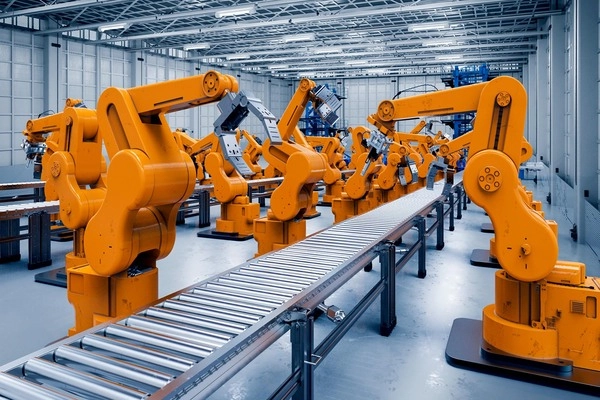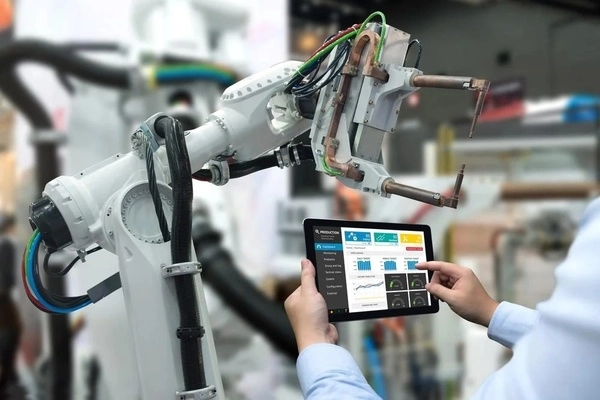In the era of Industry 4.0, IoT in manufacturing has become an essential tool that helps businesses improve efficiency, reduce costs, and optimize management. From equipment monitoring to process automation, the Internet of Things (IoT) delivers smart, data-driven solutions that enable factories to operate more efficiently and flexibly in product development. This article will explore the concept, role, practical applications, and key considerations when implementing IoT in manufacturing.
What is IoT in manufacturing?
IoT in manufacturing refers to the use of Internet-connected devices, smart sensors, and data systems to monitor, control, and optimize production processes. These systems collect data from machines, production lines, personnel, and the surrounding environment, enabling businesses to analyze information, predict issues, and make more accurate decisions.

Implementing IoT in manufacturing is not just a technological upgrade; it is also a strategic transformation that allows businesses to operate more flexibly, reduce waste, and strengthen their competitiveness in the market. A typical manufacturing IoT system includes sensors, smart devices, management software, and data analytics platforms. These components work together seamlessly to ensure the entire factory operates efficiently.
The role of IoT in manufacturing
The role of IoT in manufacturing goes beyond mere data collection. It helps businesses predict risks, automate processes, and improve product quality. With IoT, managers can monitor the operational status of production lines in real time, detect errors as they occur, and minimize disruptions.

Furthermore, IoT in manufacturing also supports data-driven decision-making, from production planning and resource management to energy optimization. This helps businesses reduce operational costs, increase production efficiency, and enhance customer experience through high-quality products. Therefore, IoT is not only a technical tool but also a strategic factor in business development.
Applications of IoT in manufacturing
Implementing IoT in manufacturing brings a wide range of practical applications, from quality control and equipment monitoring to operational optimization and supply chain management. Below are some notable applications:
Quality management and control
IoT sensors and devices enable monitoring of product quality right from the production stage. Data collected from machines, temperature, humidity, or pressure helps detect anomalies and adjust processes promptly. As a result, businesses can reduce product defects, improve accuracy, and ensure consistency in production.

Quality management and control
IoT sensors and devices allow businesses to monitor product quality right from the production stage. Data collected from machines, temperature, humidity, or pressure helps detect abnormalities and adjust processes promptly. This enables companies to reduce product defects, improve accuracy, and maintain consistency in production.
Monitoring and smart equipment maintenance
IoT enables real-time monitoring of machine conditions, detecting signs of wear or potential failure before issues occur. Predictive maintenance based on sensor data helps reduce downtime, lower repair costs, and extend the lifespan of equipment.
Optimizing operations and machine uptime
With data collected from IoT devices, businesses can analyze operational performance, adjust production schedules, and balance machine loads. This helps optimize uptime, reduce resource waste, and increase productivity.
Supporting product development and improvement
IoT data is not only useful for operations but also aids R&D in product enhancement. By analyzing how products are used and perform in real conditions, businesses can make suitable improvements, meet customer needs, and enhance user experience.
Improving supply chain management
IoT allows real-time tracking of goods, materials, and transportation progress. Businesses can predict delivery times, reduce excess inventory, and optimize the supply chain, thereby improving management efficiency and lowering logistics costs.

Automation and smart inventory management
IoT systems help automatically update inventory levels, alert when products are running low or nearing expiration, and even reorder supplies automatically. This not only reduces human errors but also ensures a continuous and stable supply for production.
Reducing energy consumption and improving efficiency
IoT sensors monitor the energy usage of machines and electrical systems, helping businesses identify waste and adjust operations accordingly. Optimizing energy use not only lowers costs but also contributes to environmental protection.
Ensuring workplace safety in factories
IoT also plays a crucial role in ensuring worker safety. Sensors can detect hazardous conditions such as gas leaks, high temperatures, or abnormal movements, providing timely alerts to prevent workplace accidents.
Considerations when implementing IoT in manufacturing
Although IoT in manufacturing offers many benefits, businesses need to pay attention to several factors to implement it effectively:

- Initial investment costs: Implementing IoT requires spending on devices, network infrastructure, and data analytics software. Businesses need to evaluate ROI to ensure long-term effectiveness.
- Data security: IoT generates a large amount of sensitive data. Companies must implement strong security measures to prevent breaches or data loss.
- Integration with existing systems: IoT devices must be compatible with current production lines and management software. Careful planning is required to integrate them without causing disruptions.
- Staff training: Employees need to be trained in operating, monitoring, and analyzing IoT data to fully leverage the system’s potential.
- Choosing a reliable provider: Selecting a suitable and trustworthy IoT solution helps businesses implement it effectively, reduce technical risks, and ensure long-term support and warranty.
IoT in manufacturing is not just a technological trend but also a strategic factor that enhances a company’s competitiveness. From quality management, equipment monitoring, and operational optimization to automation and workplace safety, IoT offers numerous tangible benefits. However, successful implementation requires careful consideration of costs, security, system integration, and staff training. When applied correctly, IoT in manufacturing opens up powerful opportunities for digital transformation, enabling businesses to operate intelligently, efficiently, and sustainably.
